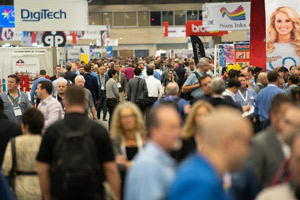 It’s not hyperbole to say that the live events industry — and the diverse print demand that accompanies it — was all but demolished by pandemic closures and restrictions over the past year. It’s also true (and reasonable) that the COVID-19 recovery legislation passed by Congress to date has been aimed at mitigating immediate health, societal, and economic crises brought on by the pandemic. Targeted government assistance has been aimed at industry sectors hit hardest in real-time, such as airlines and restaurants. But as we finally begin to poke our collective heads out into an increasingly vaccinated world, it is time for Congress to address the next phase of industry sector relief and recovery. The restart of live events — and, specifically, live business events, such as trade shows, conferences, exhibitions, and business meetings — is one such sector that Congress can and should begin to address now.
It’s not hyperbole to say that the live events industry — and the diverse print demand that accompanies it — was all but demolished by pandemic closures and restrictions over the past year. It’s also true (and reasonable) that the COVID-19 recovery legislation passed by Congress to date has been aimed at mitigating immediate health, societal, and economic crises brought on by the pandemic. Targeted government assistance has been aimed at industry sectors hit hardest in real-time, such as airlines and restaurants. But as we finally begin to poke our collective heads out into an increasingly vaccinated world, it is time for Congress to address the next phase of industry sector relief and recovery. The restart of live events — and, specifically, live business events, such as trade shows, conferences, exhibitions, and business meetings — is one such sector that Congress can and should begin to address now.The live business events sector drives a huge amount of print demand, particularly in the apparel, promotions, wide-format, and commercial print segments. Indeed, print is a key player in the live business events ecosystem, which includes show and event organizers, venues and destinations, and suppliers, such as print. In 2019, the business events landscape represented an economic impact of $396 billion and drove federal and state tax revenues to the tune of $51 billion and $79 billion, respectively. Indirect spending on associated activity, such as meals, lodging, and transportation services, added to these amounts.
The live business events sector also spurs innovation; an estimated $700–$970 billion in sales value was associated with live business events in 2019. This is likely no surprise to printing company owners, OEMs, and other print suppliers who make attending and exhibiting at industry shows like PRINTING United Expo a critical part of their annual business plans. And, while the live business events industry has adjusted admirably to provide virtual programming as a substitution for in-person gatherings, it’s clear that the only path back to the economic and innovation benefits noted above is one that revives this sector to its pre-pandemic normalcy.
There are three key elements to restarting the live business events industry. This includes:
• Personal Safety: While vaccines and “herd immunity” is likely the ultimate driver of an individual’s personal health and safety decisions related to attending live business events, there is a need for the live business events industry to promote its unique safety features. Unlike “mass gatherings” in venues with fixed seating, such as stadiums or auditoriums, business events are “controlled gatherings” that can be designed from the outset to conform with Centers for Disease Control and Prevention, state, and local safety requirements. Social distancing can be accomplished by spacing exhibit booths appropriately, for example. Of course, printed products, like floor graphics or signage, are also key to promoting safety measures in order to reduce virus transmission risks consistent with public health guidelines.
• Economic Incentives: Personal safety assurances won’t be enough to restart the live business events sector, however. As nearly every industry is reeling from a tough pandemic year, added incentives such as tax credits or other forms of economic stimulus to promote participation in live business events are needed — particularly in the years 2022-23, when such events are expected to reopen fully. It’s important to note that recovery dollars targeted to the live business events sector serve as their own “stimulus package,” since multiple industries will in turn be revived by the business connections, product launches, and sales that result from these gatherings. Offsets to comply with new safety procedures, such as enhanced cleaning or required PPE, are also necessary.
• Liability Protections: The reality is that even with the best-laid safety plans and excellent value propositions, the live business events ecosystem will still be at the mercy of unprecedented acts, such as COVID-19. A lesson learned from 2020 is that this sector needs tailored liability protections in the form of expanded insurance coverage and safe harbor from frivolous litigation. This is particularly important for small businesses, which are the backbone of this sector. More than 90% of events companies and print suppliers employ fewer than 500 workers and are most susceptible to taking a financial hit in unpredictable times.
So, can all of these elements come together to restart the live business events industry? Yes, and Congress is in a position to make that happen sooner than later. Fortunately, some relief has already become law, such as Small Business Administration loan programs like PPP or EIDL, and cost recovery for providing workforce PPE. The next step Congress can take to help revive this industry sector is passage of the bipartisan “Hospitality and Commerce Jobs Act of 2021,” the centerpiece of which are two convention/trade show restart tax credits. Specifically, the Act would create two time-limited tax credits: one equal to 50% of the qualified participation costs paid or incurred by a taxpayer, and one equal to 100% of the qualified restart costs paid or incurred by an eligible provider. Examples of restart costs would include, but are not limited to, renovation, testing, or labor costs needed to prevent the spread of COVID-19. The Act would also temporarily restore the Entertainment Business Expense Deduction by repealing the changes made to it by the 2017 Tax Cuts and Jobs Act. These provisions would apply to taxable years 2022-23.
Congress must also come together to pass meaningful liability protections. Multiple bills have been floated to create a Pandemic Reinsurance Act (known as PRIA), which would serve a similar function to the Terrorism Reinsurance Act passed post-9/11 aimed at protecting the commercial real estate sector. Legislation has also been introduced to institute a timely, targeted liability shield for employers who are conducting business in a good faith manner that protects employees and customers. This type of law would reduce the trepidation that many companies feel toward getting back into the live business events space.
PRINTING United Alliance is partnering with Go Live Together to urge Congress to adopt the measures outlined above as a means to restart this live business events industry — and to boost its extended supplier base, such as printing and packaging companies. If your company is part of this once-vibrant ecosystem, please take time to reach out personally to your senators and representative to urge support of these initiatives. You can access a pre-written message via the Go Live Together campaign here. If you choose to customize your message, please be sure to quantify the “before and after” pandemic costs your company has experienced. Additionally, the Go Live Together campaign is providing shareable advocacy resources, such as videos and infographics, that your company may wish to share with its stakeholders and on social media channels. Let’s work together to create a buzz for the return of live business events and the print it generates!

Lisbeth Lyons is VP, Government & Political Affairs, PRINTING United Alliance, the largest, most comprehensive member-based printing and graphic arts association in the U.S.. With more than 20 years of experience representing the voice of business on Capitol Hill, Lisbeth advocates for public policies that protect and advance the economic future of the printing and packaging industry. She oversees PRINTING United Alliance’s legislative, political, and grassroots advocacy initiatives, and has served in executive leadership of multiple successful advocacy campaigns, such as Coalition for Paper Options, Coalition for a 21st Century Postal Service, and Stop Tariffs on Printers & Publishers Coalition.
PRINTING United Alliance members have exclusive access to preeminent education; training; workshops; events; research; governmental and legislative representation; safety and environmental sustainability guidance; and resources from the leading media company in the industry — NAPCO Media.
In this article, Lisbeth addresses legislative solutions to restarting the live business events sector in a post-pandemic world. More information about this initiative can be found at sgia.org, or by reaching out to Lisbeth should you have additional questions specific to how these issues may affect your business.
To become a member of PRINTING United Alliance and learn more about how PRINTING United Alliance subject matter experts can assist your company with services and resources such as those mentioned in this article, please contact the Alliance membership team: 888-385-3588 / membership@printing.org.
